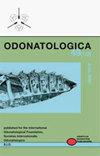A misleading representation of the asian distributioof a most intriguing dragonfly, somatochlora sahlbergi trybom, 1889: a critique of KOHLI et al. (2018)
IF 0.4
4区 农林科学
Q4 ENTOMOLOGY
引用次数: 0
Abstract
Recently Kohli et al. (2018) published a phylogenetic analysis of Somatochlora sahlbergi, including extensive supplementary material listing global distribution records for the species. The compilation of literature data on records of S. sahlbergi in Siberia includes an inacceptable level of false pseudo-data and incorrect statements. Further key words. Odonata, Anisoptera, Corduliidae, Russia, Siberia, geographical distribution, circumpolar species Somatochlora sahlbergi Trybom, 1889, is considered to be the world’s ‘northernmost dragonfly’. It has a charismatic appeal for European and North American odonatologists as it is one most difficult species to encounter, especially in Europe (Hämäläinen 2015). It was thought to be confined to high latitudes within or near the Arctic Circle until Belyshev & Ovodov (1961) discovered it at a latitude of 51°45’N in Irkutsk Province in Russia. Since then, evidence has accumulated indicating that the species’ range extends to the mountains of southern Siberia and the northern Khabarovskiy Kray (Kosterin 1992; Schröter 2011). The geographical distribution of the species was thoroughly reviewed by Schröter (2011), who provides detailed and precise maps of its known localities for the northern hemisphere in general, including Europe, Siberia and North America. However, that review does not give text accounts of known localities for the species. Recently, a highly interesting insight into phylogeography of S. sahlbergi对一种最有趣的蜻蜓的亚洲分布的误导性描述,somatchlora sahlbergi trybom,1889:对KOHLI等人的批评。(2018)
最近,Kohli等人(2018)发表了一份关于Somatochlora sahlbergi的系统发育分析,包括大量补充材料,列出了该物种的全球分布记录。西伯利亚萨赫贝尔吉记录的文献数据汇编包括不可接受的虚假伪数据和不正确的陈述。进一步的关键词。Ododata,Anioptera,Cordulidae,俄罗斯,西伯利亚,地理分布,环极物种Somatochla sahlbergi Trybom,1889年,被认为是世界上“最北端的蜻蜓”。它对欧洲和北美的牙齿学家有着非凡的吸引力,因为它是最难遇到的物种之一,尤其是在欧洲(Hämäläinen,2015)。它被认为局限于北极圈内或附近的高纬度地区,直到Belyshev和Ovodov(1961)在俄罗斯伊尔库茨克省北纬51°45’处发现它。从那时起,越来越多的证据表明,该物种的范围延伸到西伯利亚南部和哈巴罗夫斯克边疆区北部的山区(Kosterin 1992;Schröter 2011)。Schröter(2011)对该物种的地理分布进行了彻底的审查,他提供了北半球(包括欧洲、西伯利亚和北美)已知地点的详细而精确的地图。然而,这篇综述并没有给出该物种已知位置的文字说明。最近,一个非常有趣的见解对S.sahlbergi的系统地理学
本文章由计算机程序翻译,如有差异,请以英文原文为准。
求助全文
约1分钟内获得全文
求助全文
来源期刊

Odonatologica
生物-昆虫学
CiteScore
1.20
自引率
0.00%
发文量
1
审稿时长
>12 weeks
期刊介绍:
Odonatologica publishes original articles in all fields of odonatology. Review articles, i.e., original and critical accounts of important, rounded-off topics, are also explicitly welcome, but authors who plan to write a review should contact the Editor first.
 求助内容:
求助内容: 应助结果提醒方式:
应助结果提醒方式:


